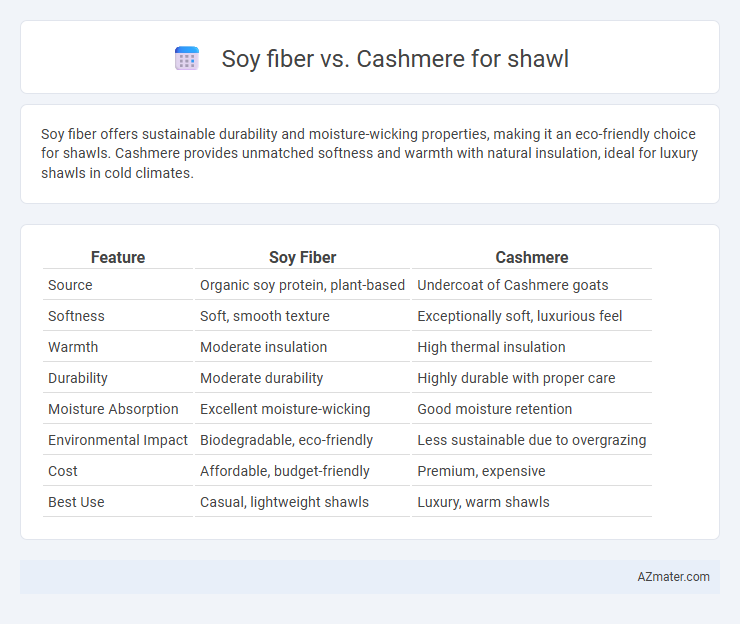Soy fiber offers sustainable durability and moisture-wicking properties, making it an eco-friendly choice for shawls. Cashmere provides unmatched softness and warmth with natural insulation, ideal for luxury shawls in cold climates.
Table of Comparison
| Feature | Soy Fiber | Cashmere |
|---|---|---|
| Source | Organic soy protein, plant-based | Undercoat of Cashmere goats |
| Softness | Soft, smooth texture | Exceptionally soft, luxurious feel |
| Warmth | Moderate insulation | High thermal insulation |
| Durability | Moderate durability | Highly durable with proper care |
| Moisture Absorption | Excellent moisture-wicking | Good moisture retention |
| Environmental Impact | Biodegradable, eco-friendly | Less sustainable due to overgrazing |
| Cost | Affordable, budget-friendly | Premium, expensive |
| Best Use | Casual, lightweight shawls | Luxury, warm shawls |
Introduction to Soy Fiber and Cashmere Shawls
Soy fiber shawls are crafted from natural protein extracted from soybeans, offering a sustainable, eco-friendly alternative with soft texture and moisture-wicking properties. Cashmere shawls are made from the fine undercoat of cashmere goats, prized for exceptional warmth, lightweight feel, and luxurious softness. Both fibers provide distinct comfort and style benefits, with soy fiber emphasizing sustainability and cashmere highlighting premium luxury.
Origin and Production Processes
Soy fiber, derived from the byproducts of soybean processing in East Asia, undergoes a chemical and mechanical process to convert protein-rich soybean hulls into soft, biodegradable yarn ideal for eco-friendly shawls. Cashmere, sourced from the undercoat of cashmere goats native to Mongolia and China, involves a meticulous hand-combing process during molting seasons to harvest fine, luxurious fibers known for exceptional warmth and softness. The contrasting origins and production techniques of soy fiber and cashmere highlight the natural versus agricultural roots influencing the texture, sustainability, and cost of shawls made from these materials.
Texture and Feel: Comparing Softness
Soy fiber offers a smooth, silky texture with a gentle sheen, providing a lightweight and breathable softness ideal for shawls. Cashmere delivers an unmatched plush feel, characterized by its luxurious warmth and exceptional softness that feels cozy against the skin. When comparing softness, cashmere typically surpasses soy fiber due to its fine, downy fibers, but soy fiber's smoothness and sustainability make it a comfortable alternative.
Durability and Longevity
Soy fiber exhibits excellent durability and resistance to wear, making it a practical choice for a shawl that maintains its integrity over time. Cashmere, while luxuriously soft and lightweight, requires more careful handling due to its delicate fibers, which are prone to pilling and stretching. In terms of longevity, soy fiber shawls often outlast cashmere ones without significant degradation in texture or appearance.
Warmth and Insulation Capabilities
Soy fiber offers moderate warmth and moisture-wicking properties, making it suitable for lightweight shawls with breathable insulation. Cashmere provides superior warmth and exceptional insulation due to its fine, soft fibers that trap body heat effectively. Shawls made from cashmere are preferable in colder climates for maximum thermal comfort and lightweight insulation.
Breathability and Comfort
Soy fiber shawls offer superior breathability due to their natural moisture-wicking properties and lightweight texture, making them ideal for warm climates. Cashmere provides exceptional softness and warmth with excellent insulation but may retain heat, reducing breathability in warmer conditions. Both fibers deliver comfort, though soy fiber excels in moisture management while cashmere is preferred for cozy, cold-weather use.
Environmental Impact and Sustainability
Soy fiber, derived from soybean protein, offers a biodegradable and renewable alternative for shawls, requiring less water and pesticides compared to traditional fibers. Cashmere production involves high methane emissions and extensive grazing, often leading to land degradation and biodiversity loss in sensitive regions. Choosing soy fiber over cashmere supports lower carbon footprints and promotes sustainable textile practices in shawl manufacturing.
Hypoallergenic Properties
Soy fiber shawls offer excellent hypoallergenic properties due to their natural protein structure, which resists allergens and irritants better than many traditional fibers. Cashmere, while luxurious and soft, can sometimes cause allergic reactions in sensitive individuals because of its fine animal fibers and lanolin content. Choosing soy fiber for shawls ensures a gentle, non-irritating wear experience ideal for those with sensitive skin or allergies.
Price and Accessibility
Soy fiber shawls typically offer a more affordable price point compared to cashmere, making them accessible to a broader range of consumers seeking sustainable alternatives. Cashmere shawls, renowned for their luxurious softness and warmth, come at a premium cost due to the labor-intensive process of harvesting fibers from cashmere goats. Availability of soy fiber shawls is increasing with advancements in textile manufacturing, while authentic cashmere remains limited by regional production centers, primarily in Mongolia and China.
Styling and Care Tips
Soy fiber shawls offer a smooth, silky texture with excellent moisture-wicking properties, making them ideal for layering in both casual and formal outfits; their lightweight nature drapes elegantly without adding bulk. Cashmere shawls provide luxurious warmth and a soft, plush feel, perfectly complementing sophisticated, winter-ready ensembles while elevating any style with timeless elegance. To maintain soy fiber shawls, hand wash with mild detergent and air dry to preserve softness and shape, while cashmere requires gentle hand washing or dry cleaning, avoiding excessive heat to prevent fiber damage and pilling.

Infographic: Soy fiber vs Cashmere for Shawl
 azmater.com
azmater.com